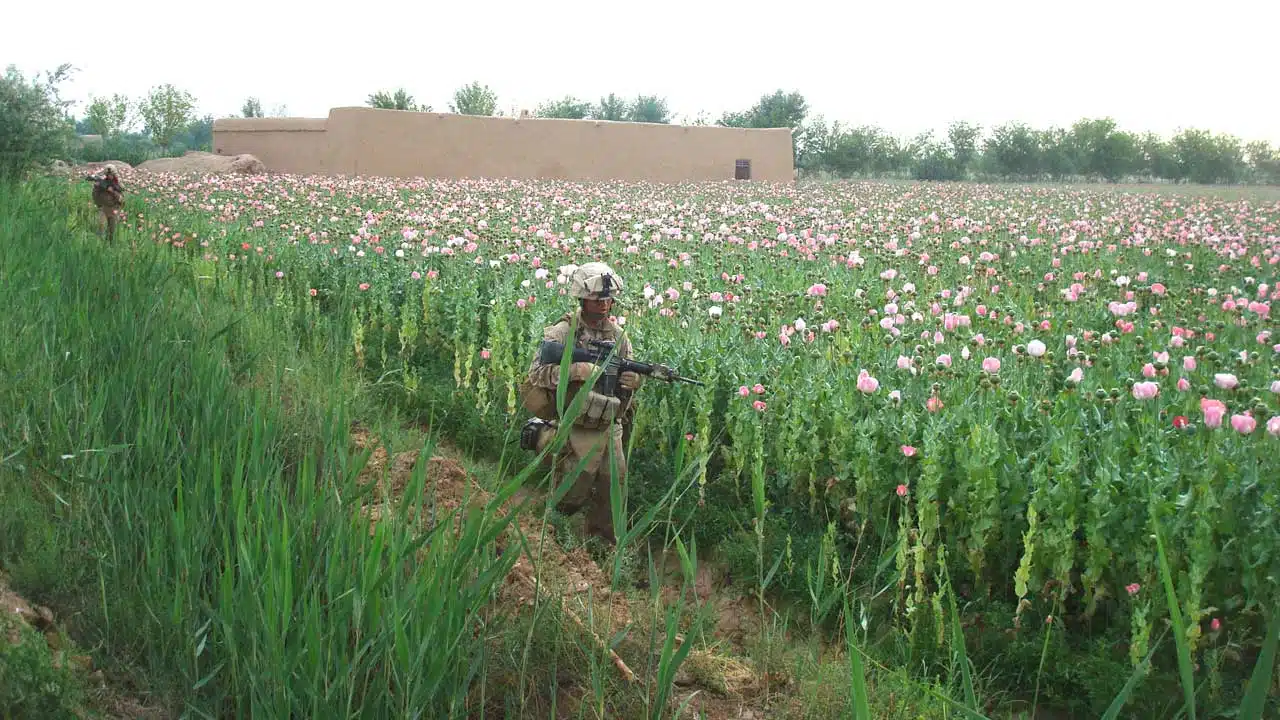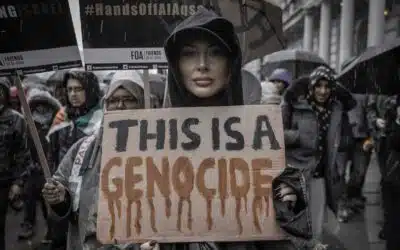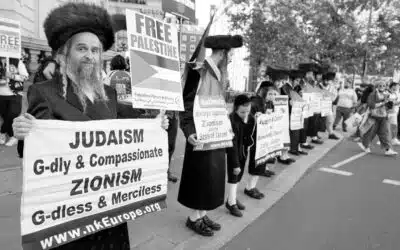Earlier this year, Jane’s Information Group ranked Afghanistan as one of the world’s most unstable countries, following the Palestinian territories and Somalia. Last month, Foreign Policy magazine ranked Afghanistan at number eight on its failed states index.
Violence in Afghanistan has grown steadily over the years, so that it is now higher than an other time since the US war to overthrow the Taliban after the September 11 terrorist attacks.
The US alleged that Osama bin Laden was responsible for those attacks and demanded that the Taliban turn him over. The Taliban agreed to enter negotiations on the matter on the condition that they be shown the evidence linking bin Laden to the attacks. The US refused to provide evidence and instead launched major military operations, using airpower and Northern Alliance warlords as proxy forces to overthrow the regime.
The Pentagon issued a report to Congress last month that said, “The Taliban regrouped after its fall from power and have coalesced into a resilient insurgency…. The Taliban is likely to maintain or even increase the scope and pace of its terrorist attacks and bombings in 2008.” It noted “two distinct insurgencies”, the Taliban to the south and a “more complex, adaptive insurgency” by other militant groups in the east.
The report noted that the use of improvised explosive devices (IEDs), the same kind of weapons the Pentagon has blamed for causing many of the casualties in Iraq, is now growing in Afghanistan.
Helmand province in southern Afghanistan is dominated by the Taliban and is responsible for more than half of the country’s opium production. The drugs trade is a major source of income for the Taliban, which had virtually eradicated the crop prior to the US war.
The drugs trade flourished during the Soviet-Afghan war and helped to finance the mujahedeen’s efforts to fight the Soviet occupation. The CIA, if not directly involved in trafficking, was at least complicit in turning a blind eye as Afghanistan grew to become the world’s leading producer of opium.
The Taliban, after its rise to power, tried to control the trade, imposing taxes and monopolizing areas where poppy cultivation was allowed to continue. As their control became more strict they eradicated most production, arguing that opium use was against Islamic law (while itself profiting from the trade). According to UN figures, the amount of land used for poppy cultivation plummeted from 82,000 hectares in 2000 to just 8,000 in 2001.
As a result of the US overthrow of the Taliban, poppy cultivation once again exploded: 74,000 hectares in 2002, 80,000 in 2003, 131,000 in 2004. Cultivation increased 17% in 2007 from the previous year, nearly doubling figures from 2005, and accounting for 92% of the world’s opium production.
The UN estimated that the Taliban earned $200-400 million last year through a tax on poppy farmers. The drugs trade itself was estimated to bring in about $4 billion to farmers and traffickers, half the national income of the country.
Although it has been estimated that 3 million Afghans had returned home from Pakistan, where millions of refugees fled to during the Soviet-Afghan war, there are still more than 2 million registered Afghan refugees in Pakistan.
The Soviet-Afghan war began in 1979 when the USSR invaded Afghanistan. Six months prior to the invasion, the US began supporting the Afghan mujahedeen against the government of Afghanistan. According to President Carter’s National Security Advisor Zbigniew Brzezinski, the purpose of the decision to provide covert aid to Islamic extremists was to prompt a Soviet intervention and give the USSR its own “Vietnam” war.
Refugees are mostly in Pakistan’s northwestern frontier and tribal areas, where militant groups have increasingly gained control and use the territory to launch attacks against US and NATO forces in Afghanistan. Militant leaders now using Pakistan as a base to fight the foreign presence in Afghanistan include former US allies, such as Gulbuddin Hekmatyar, who was a key CIA asset during the Soviet-Afghan war.
Osama bin Laden began his al-Qaeda organization during that war to provide support to the mujahedeen. Prior to establishing al-Qaeda, he travelled to the region from Saudi Arabia to assist the mujahedeen effort, arriving in 1985 in Peshawar, where the CIA, acting through the ISI (Pakistan’s intelligence agency) as its proxy, had based many of its own operations. It’s not clear whether bin Laden received any direct aid from the US, but al-Qaeda and bin Laden’s operations must certainly have been known to and looked upon with approval by the CIA.
According to the UN, Afghanistan has one of the world’s highest rates of infant and child mortality. One out of five children will not live past the age of five. Well over a third of Afghanistan’s children are malnourished. 40 percent are underweight, and more than half are stunted.
Afghan President Hamid Karzai has increasingly come under criticism for being an ineffective leader who has been unable to stem the growing tide of insurgency and influence of the Taliban. Karzai in turn has lashed out at the US and NATO forces for causing high numbers of civilian casualties and for its detention policies which only serve to fuel resistance to his US-backed government.
In one example of excessive force only helping to fuel the insurgency, British forces have used the Hellfire AGM-114N thermobaric missile in Afghanistan, a weapon that creates a vacuum so powerful that it sucks the air out of human targets and crushes their bodies. The warhead is loaded with fluorinated aluminum powder that disperses and then ignites upon detonation, creating a massive secondary blast that creates pressure up to 430 pounds per square inch. Victims often die from asphyxiation prior to their organs being shredded.
The weapon is condemned by human rights groups. Human Rights Watch calls the weapons “particularly brutal” and indiscriminate. A British Ministry of Defense spokesman defended the use of the weapon, saying, “We no longer accept the term thermobaric as there is no internationally agreed definition. We call it an enhanced blast weapon.” According to the Sunday Times, “The weapons are so controversial that MoD weapons and legal experts spent 18 months debating whether British troops could use them without breaking international law. Eventually, they decided to get round the ethical problems by redefining the weapons.”
The weapon’s manufacturer, Lockheed Martin, markets them as thermobaric, or vacuum bombs. US President George W. Bush has said, “There are going to be some awfully surprised terrorists when the thermobaric Hellfire comes knocking.”
Karzai has also suggested that one key to resolving the violence would be to close down militant bases of operations in Pakistan.
Many Taliban and al Qaeda militants fled across the border to Pakistan as a result of the US war in Afghanistan, where they found refuge in the northwestern tribal territories. But the growing presence of militant groups there has led to increased instability in Pakistan. While anti-US sentiment in the region resulted in initial sympathies for the militants, as the local population became increasingly terrorized by the groups and their stringent interpretations of Islamic law, this sympathy has largely turned into fear and enmity.
In April, Karzai narrowly missed being assassinated during “Mujahedeen Day” (celebrating the victory of the mujahedeen over the Soviet Union) military parade. According to the New York Times, “The ability of the attackers to get so close to Mr. Karzai, who escaped unhurt, suggested they had inside help.” The Taliban claimed responsibility. A Taliban spokeswoman said, “We cannot say Afghanistan is free. Afghanistan is still under the domination of infidels.”
Last month, Karzai’s government accused Pakistan intelligence of being behind the failed assassination plot, saying that authorities have evidence of direct involvement of Pakistan’s Inter-Services Intelligence, or ISI.
Sayeed Ansari, spokesman for the Afghan intelligence service, said, “Based on the investigation of the case and documents we found, as well as confessions by suspects we arrested, they show that the real schemers and organizers of the terrorist attack is the intelligence organization of Pakistan, ISI, and its associates, which committed unforgivable crimes.”
The ISI has long been criticized for its close ties with many militant groups and terrorists. The agency served as the CIA’s intermediary in financing, arming, and training the mujahedeen during the Soviet-Afghan war. Following that, Pakistan became the Taliban’s biggest benefactor and was supported by the ISI. There have also been links between the intelligence agency and Kashmiri militants, and India has accused the ISI of involvement in terrorist attacks.
Following the attacks of 9/11, it was reported that the ISI chief, Mahmud Ahmed, had been responsible for wiring $100,000 to hijacker Mohammed Atta in Florida. As a result of the allegation, Ahmed was quietly replaced. The 9/11 Commission, for its part, stated that the question of who financed the 9/11 operations was “of no practical significance”.
The charge of ISI involvement in the assassination attempt came just a week after Karzai had threatened to send Afghan forces into Pakistan to fight militant groups operating across the border and using the region as a base for attacks in Afghanistan, further escalating tensions in the region.
The regime of Pakistan President Pervez Musharraf has been strongly supported by the US. After 9/11, Pakistan ostensibly agreed to end its support for the Taliban and join the US in its war on terrorism. He has been lauded as a key “ally” in the war on terrorism and his government provided with billions in financing and military equipment.
Musharraf, who came to power in in 1999 in a bloodless coup that overthrew now opposition leader Nawaz Sharif, was reelected last year in a controversial election. Most of the Parliament walked out to protest that the vote was even being held, since Musharraf was still head of the military. The Supreme Court was expected to decide that the election had been illegal since Musharraf had not resigned from his military post before the vote. To counter this threat to his authority, he implemented martial law and cracked down on his political opposition, dismissing members of the Supreme Court, arresting lawyers, and cracking down on the media.
Early this year, a new government was formed after elections that placed parties opposed to Musharraf and his policies in power. Public disapproval of Musharraf is enormous, but despite an earlier promise to step down if the public wished it, he has more recently declared that he will cling to power so long as he feels like it’s in Pakistan’s best interests for him to do so.
The new government has taken a different approach to dealing with the militant groups in its northwestern frontier territories, pointing out that it was the US’s “war on terrorism” itself that had led to the increasing power of militant groups, and opting to engage in dialogue with militant and local tribal leaders. The US heavily criticized this approach, blaming it for the increase in insurgent attacks in Afghanistan despite the fact that the trend had shown increasing attacks long before the new government even came to power and that attacks had always surged in the spring after the thaw in the mountains.
At the same time, the Pakistan government has shown a willingness to use force if necessary to prevent the militants from gaining more ground. The city of Peshawar came under threat of being taken over by militants. The government deployed the paramilitary Frontier Force to defend the city, destroying bases of Mangal Bagh, leader of a group known as Lashkar-i-Islam, the Army of Islam, which was alleged by one Pakistani government official to be a creation of the ISI.
As a result of the operations, Baitullah Mehsud, the leader of the Pakistani Taliban, announced that he would suspend participation in peace talks with the government.
As with Afghanistan, the Pakistani government has criticized the US for its use of force, such as the recent killing of Pakistani troops. The US defended the action as an act of “self defense” despite the fact that in the airstrike occurred on Pakistani soil.
Last week, the leader of the Pakistan Peoples Party and widower of former Prime Minister and party leader Benazir Bhutto, who was assassinated late last year, criticized the West’s role in bringing Pakistan to the state it is in today, saying, “We were exploited under (British) colonialism, manipulated as a tool of Cold War intrigue, made into surrogates for a war against the Soviets in Afghanistan.” After the Soviets withdrew from Afghanistan, “Pakistan and the country we liberated were abandoned to the forces of extremism and fanaticism.”



